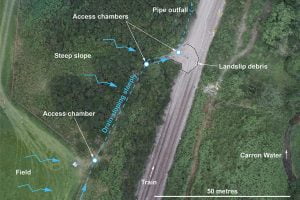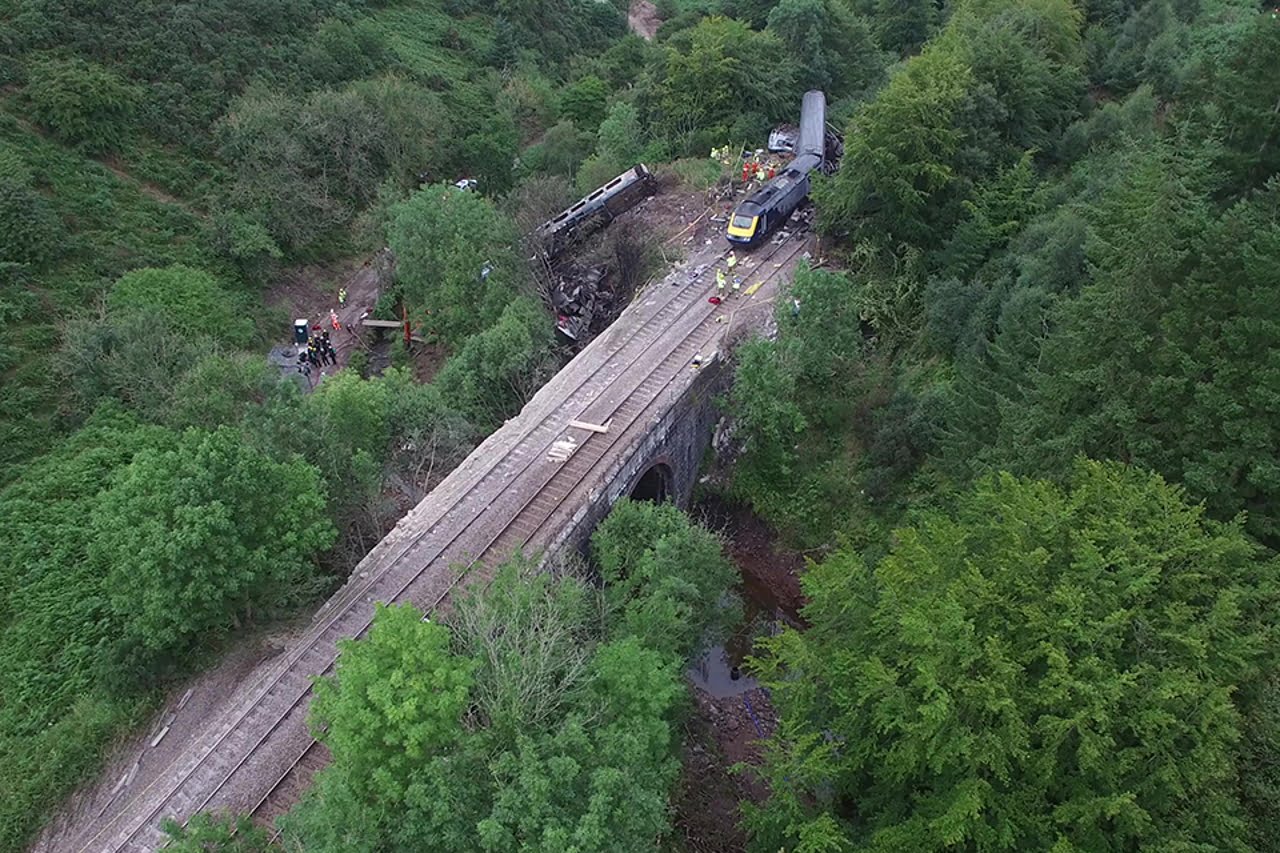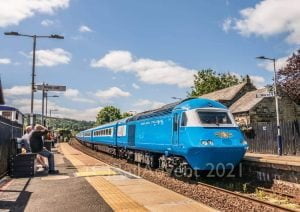The RAIB is currently investigating the fatal accident that happened near Carmont on the mainline in Scotland, and have released some additional information.
At 09:38, on Wednesday 12th August 2020, all six train vehicles derailed after hitting a landslip 1.4 miles north-east of Carmont.
There were nine people on board the train at the time of the accident.
Sadly, the driver of the train, the train’s conductor and one passenger suffered fatal injuries in the accident. The remaining passengers and member of the train crew were taken to hospital.
The morning of 12th August 2020 saw thunderstorms and heavy rain in Scotland. Weather reports show that between 5 am and 9 am, around 52mm of rain fell in the Carmont area (nearly 75% of the total rainfall for Aberdeenshire in an average August).
The site of the accident is approximately four miles south-west of Stonehaven and 20 miles north of Montrose. The train, which was operated by ScotRail, was a High Speed Train set with a leading power car, four Mark 3 passenger coaches and a rear power car.
The train was operating 1T08 06:38 Aberdeen to Glasgow Queen Street. The train had departed both Aberdeen and Stonehaven on time.
After departing Stonehaven, 1T08 continued past Carmont until it was stopped by the signaller at Carmont at 06:59 as he had just received a report from 2B13 (a train travelling north) that a landslip was obstructing the line between Carmont and Laurencekirk.
1T08 stood still south of Carmont for more than two hours until just after 9 am when the rain had stopped, the skies cleared and by 09:30, there was bright sunshine.
2B13, which had reported the landslip, had been held at Stonehaven due to reports of flooding between Stonehaven and Aberdeen.
At 09:10, after passengers had alighted, 2B13 moved forward to create space at Stonehaven.
It was then apparent that 1T08 could not continue its journey south, and the decision was taken to run it back towards Stonehaven.
At 09:25, 1T08 was given permission to start moving north, and was routed over a crossover at Carmont so that it was on the down line. The signaller at Carmont had cleared for the train to proceed to Stonehaven, and the train continued north, going over the crossover at 5mph at 09:36.
Its speed increased after the crossover, reaching 72.8mph after it had travelled for 1.4 miles, which is within the 75mph speed limit for HSTs on this stretch of line.
At around 09:38, the train struck a landslip and derailed. As the track curved to the right, the train continued straight and struck the bridge parapet (which was destroyed), the leading power car continued most of the way over the bridge and fell down a wooded embankment, as did the third carriage.
The first carriage came to rest on its roof, having rotated to be at right angles to the track. The second carriage overturned and came to rest on the second carriage, the fourth carriage remained upright and attached to the rear power car, but came to rest on the first carriage. All wheelsets of the rear power car derailed but remained upright.
In the area where the derailment happened, on the left side of the railway (in direction of travel of 1T08), a slope rises to a field which then slopes away from the railway.
A drain runs along the lower edge of the field until it reaches a chamber 50 metres from the landslip area. From here, it runs diagonally down the slope (passing two more chambers) until it reaches an outfall structure at track level which takes water towards Carron Water.

The drain running diagonally has 450-millimetre diameter plastic pipe laid at the bottom of a trench, which is filled with gravel. Water flowing from the land above the railway washed some of this gravel onto the railway, together with some larger pieces of rock which had formed part of soil eroded from the sides of the trench.
The RAIB is currently performing an extensive investigation and will release its findings in due course. Network Rail has also promised action after the accident (more information on that available here).
A fundraiser has been set up in memory of the train crew that have sadly died in the accident, more information on this can be found by clicking here.
The Office of Rail and Road has issued this statement: “Our thoughts remain with the families and friends of those who lost their lives and those impacted by yesterday’s tragic incident.
“Britain’s railways have an excellent safety record and incidents like yesterday are thankfully rare. There are increasing risks from extreme weather which are well known in the industry and our recent annual health and safety report showed that there have been six times more flooding events and a trebling of earthworks failures on Britain’s railways in the last year.
“We look forward to receiving the outcome of the review, in addition to plans from Network Rail responding to the requirement we set out last month for improvements to the monitoring of assets and more sophisticated responses to forecast adverse weather.”
Where Next?
RailAdvent Plus
Get image downloads, Prints and Streaming Video
News Homepage
For the Latest Railway News
RailAdvent Online Shop
Railway Prints, DVD’s / Blu-Ray’s and more
LocoStop – The RailAdvent Community
Come and share your railway pictures
Mainline UK Steam Info
Upcoming mainline steam tours/loco movements





Responses
The weather can cause these things without any warning. Which is why landslides do happen often or when so much water and the ground can’t take the weight of the rain. Then disaster does happen. Even in poorer countries that have seen landslides too often.
Surprised at the speed in the circumstances; in such conditions it would not be unreasonable to impose a blanket restriction such as is often done in high winds, and certainly in areas where landslips had already been reported. Will be interested to see recommendations in due course.